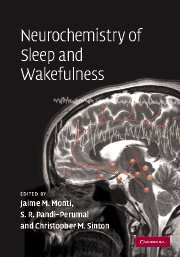Book contents
- Frontmatter
- Contents
- List of contributors
- Preface
- Acknowledgements
- Abbreviations
- I The neurochemistry of the states of sleep and wakefulness
- 1 Neurochemistry of the preoptic hypothalamic hypnogenic mechanism
- 2 Neuroanatomical and neurochemical basis of wakefulness and REM sleep systems
- 3 Rapid eye movement sleep regulation by modulation of the noradrenergic system
- II The influence of neurotransmitters on sleep and wakefulness
- III Changing perspectives
- Index
- Plate section
2 - Neuroanatomical and neurochemical basis of wakefulness and REM sleep systems
from I - The neurochemistry of the states of sleep and wakefulness
Published online by Cambridge University Press: 23 October 2009
- Frontmatter
- Contents
- List of contributors
- Preface
- Acknowledgements
- Abbreviations
- I The neurochemistry of the states of sleep and wakefulness
- 1 Neurochemistry of the preoptic hypothalamic hypnogenic mechanism
- 2 Neuroanatomical and neurochemical basis of wakefulness and REM sleep systems
- 3 Rapid eye movement sleep regulation by modulation of the noradrenergic system
- II The influence of neurotransmitters on sleep and wakefulness
- III Changing perspectives
- Index
- Plate section
Summary
Introduction
The functional states of the central nervous system are determined not only by the inputs received from the external world but also by internally generated electrical and chemical signals. These internally generated signals are responsible for the generation of the states we call sleep and wakefulness and for the transition between states. Neurons generate electrical signals as a result of the uneven distribution of ions across their cell membranes and the passage of ions through pores (ion channels) in these membranes. Neurotransmitters (chemical signaling molecules) are released from the processes of neurons and affect the electrical signaling of target neurons (or muscles) by opening ion channels themselves or by modulating ion channels via second messenger systems. The electrical properties of neurons involved in the control of rapid eye movement (REM) sleep and wakefulness will be described separately. Here we focus on the localization and neurochemistry of neurotransmitters involved in the control of these states.
A variety of different methodologies has been employed to investigate the neurotransmitter systems involved in control of behavioral states. Biochemical experiments have elucidated the pathways and enzymes involved in the synthesis, degradation, release and reuptake of different neurotransmitters. Immunohistochemical techniques have allowed the visualization of their cellular and subcellular distribution throughout the nervous system as well as the distribution of their receptors and uptake systems.
- Type
- Chapter
- Information
- Neurochemistry of Sleep and Wakefulness , pp. 23 - 58Publisher: Cambridge University PressPrint publication year: 2008
- 2
- Cited by



